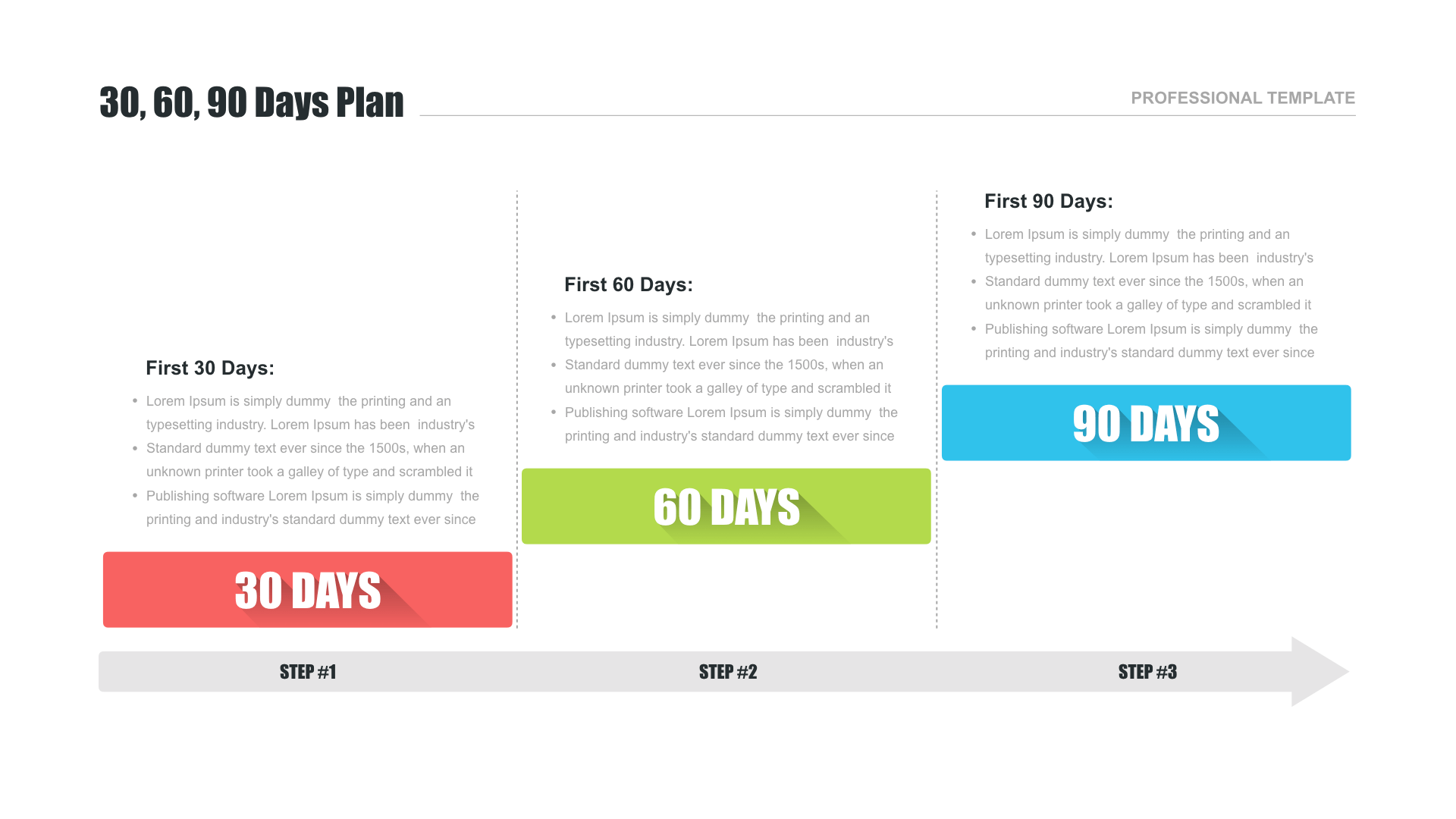Mastering Business Planning: 30-60-90 Day Plan Presentation Templates
Every business thrives on effective planning. Planning shapes the roadmap for success and progress. Plan efficiently with the structured 90-day presentation templates available. These tools enable a crystal-clear vision. They ensure that every step aligns with your goals. Let's delve into the world of 30-60-90 day business plans.
The Essence of a 30-60-90 Day Business Plan
In the dynamic world of business, establishing a roadmap is imperative. Among the multitude of planning formats, the 30-60-90 day plan has garnered significant attention. Time-bound planning, like the 30-60-90 day approach, holds immense value. Why? Because it crafts a precise path for businesses to tread upon, giving them clarity at every juncture. It isn't just about setting a timeframe; it's about ensuring goal alignment and optimal resource utilization.

The 30-60-90 day format distinguishes itself for several compelling reasons. Firstly, its structured nature ensures that businesses stay on track. Every 30-day interval acts as a checkpoint, allowing businesses to assess their progress and make necessary adjustments. Secondly, it's actionable. Unlike vague plans, this format has clear directives, making execution straightforward. Lastly, its comprehensive nature ensures that every aspect of a business process or project gets due attention. So, while the plan is time-bound, it doesn't skip on depth. With these characteristics, it becomes clear why businesses are gravitating towards this model. Let's delve deeper to decode its essence and understand its overarching significance.
Why a Time-Bound Plan?
In an age of rapid changes and swift market shifts, businesses can't afford to be stagnant or slow. This urgency gives rise to the need for plans that are both efficient and effective. Short-term goals, as seen in the 30-60-90 day plan, are beneficial as they often yield quicker results. The short timeframe creates a sense of urgency, ensuring everyone involved pushes towards the goal.
Moreover, these plans are more tangible and measurable. They are easier to monitor given the limited timeframe, allowing teams to evaluate progress with more frequency. Such regular checks help in identifying bottlenecks or areas of improvement in real-time. Furthermore, time-bound plans inherently foster agility in execution. As markets change, businesses need to be nimble in their strategies. These plans, with their concise timelines, allow for swift course corrections when external or internal factors demand a change in direction. In essence, it's a balance of proactive planning and reactive adjustments – a combination vital for modern businesses.
Breaking Down the 30-60-90 Day Template
Business plans need not be nebulous or daunting. The 30-60-90 day template serves as a testament to this. Dividing the planning period into three distinct phases allows businesses to focus, ensuring depth and precision at every step. Each phase of this template is pivotal, playing a unique role. By thoroughly grasping the intricacies of these phases, businesses can guarantee a streamlined and effective progression throughout the entire period.
First 30 Days: Setting the Foundation
Every great structure begins with a strong foundation, and business plans are no exception. The initial 30 days are all about orientation and acclimatization. It's a phase where businesses take stock of their surroundings, gauging the market environment, understanding competitors, and deciphering customer preferences.
Establishing a footing means setting the tone and direction for the upcoming journey. Here, the groundwork is laid – from initial research to strategy formulation. It's also about resource allocation, ensuring that the necessary tools, manpower, and capital are in place. The importance of setting clear expectations during this phase can't be emphasized enough. By defining roles, setting benchmarks, and delegating initial tasks, businesses lay the blueprint for the subsequent phases.
Next 60 Days: Tactical Execution
Once the blueprint is in place, it's time for action. The next 60 days are characterized by a flurry of activities aimed at bringing the strategies set in the initial phase to life. But this isn't about random or chaotic actions; it's about methodical and well-thought-out execution.
Consistent monitoring becomes the watchword. By keeping an eye on every move, businesses can measure their progress against the benchmarks set earlier. Establishing feedback loops is crucial here. This involves collecting insights, be it from customers, team members, or stakeholders. Such feedback provides real-time data, allowing businesses to pivot or tweak strategies when necessary. In essence, this phase is about making informed adjustments based on tangible results and data.
Final 90 Days: Scaling and Optimization
Reaching the 90-day mark doesn't signify the end; instead, it's about gearing up for the future. This phase is all about refinement and elevation. Every strategy, every process that has proven its worth is scaled. On the flip side, processes that lag or show inefficiencies are thoroughly optimized or, if necessary, replaced altogether.
The key here is to capitalize on successes and learn from shortcomings. The culmination of the 90 days sets the stage for future endeavors. Whether it's expanding into new markets, launching new products, or simply continuing the momentum, this phase ensures businesses are well-positioned for sustained growth and success.
Selecting the Perfect Presentation Template
Your 30-60-90 day plan deserves a visually appealing presentation. A strong template conveys your vision effectively. It captivates stakeholders and ensures clarity.
Features to Look For
An ideal template is flexible. It aligns with your brand's voice and visuals. Look for templates that offer easy customization. They should be both intuitive and professional.
Implementing Your Content
Embedding your plan in the template is crucial. The template should complement your content. Ensure clarity in data representation. Use compelling visuals and concise texts.
Conclusion
To conclude, a structured 30-60-90 day plan is invaluable. It offers clarity, direction, and a roadmap for success. With a compelling presentation, your vision becomes infectious. Stakeholders align, and the path to success becomes clear.
- Structured Planning
- Clear Vision
- Effective Execution